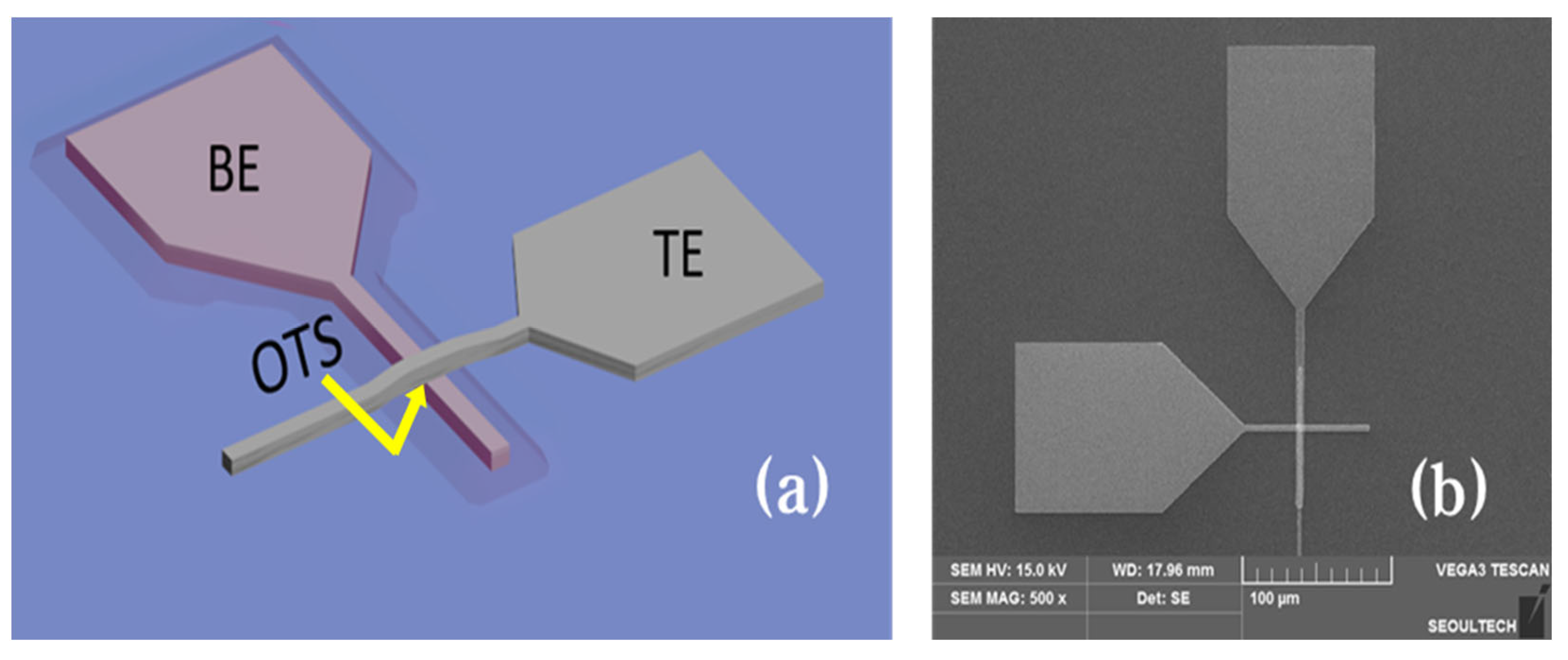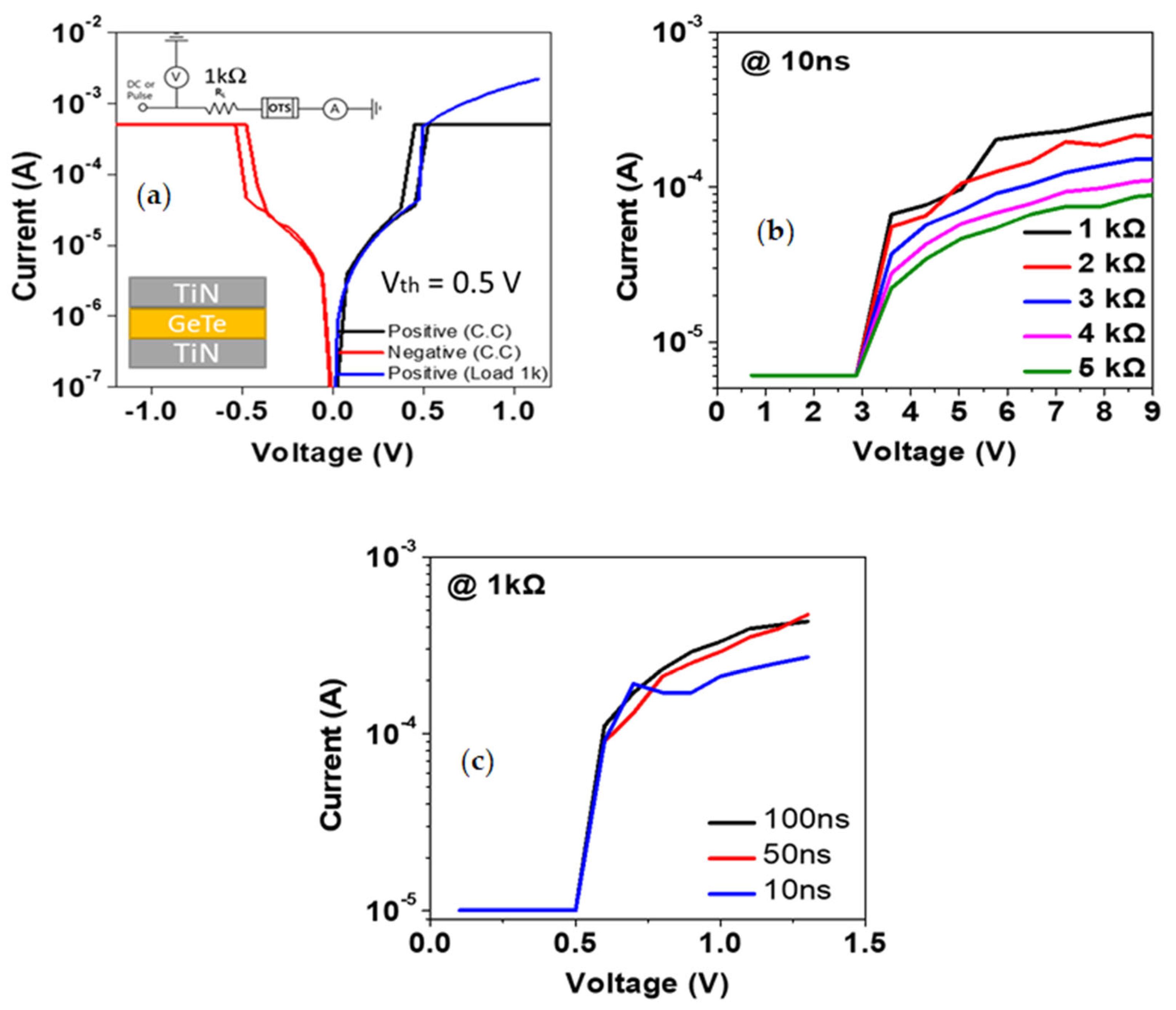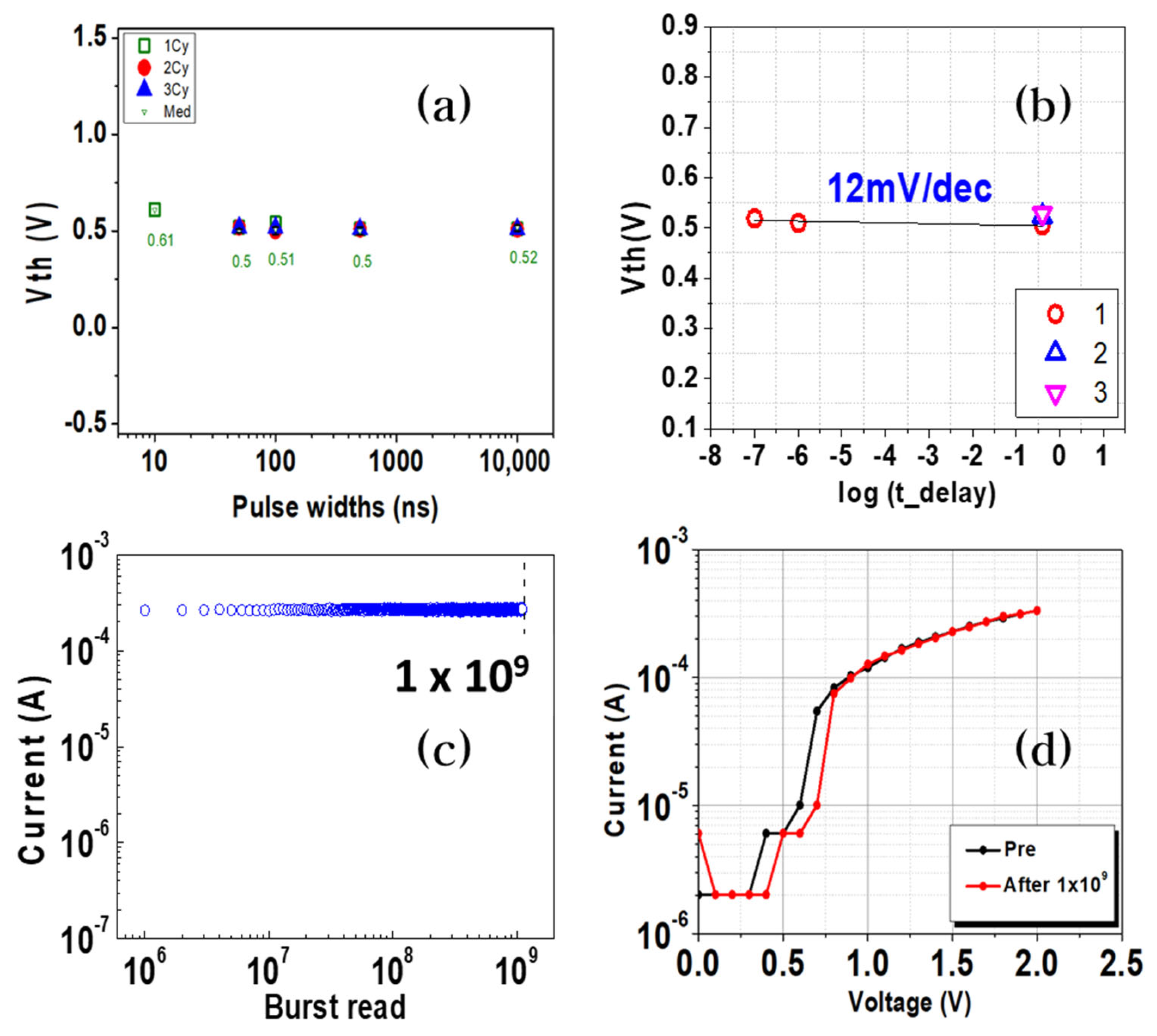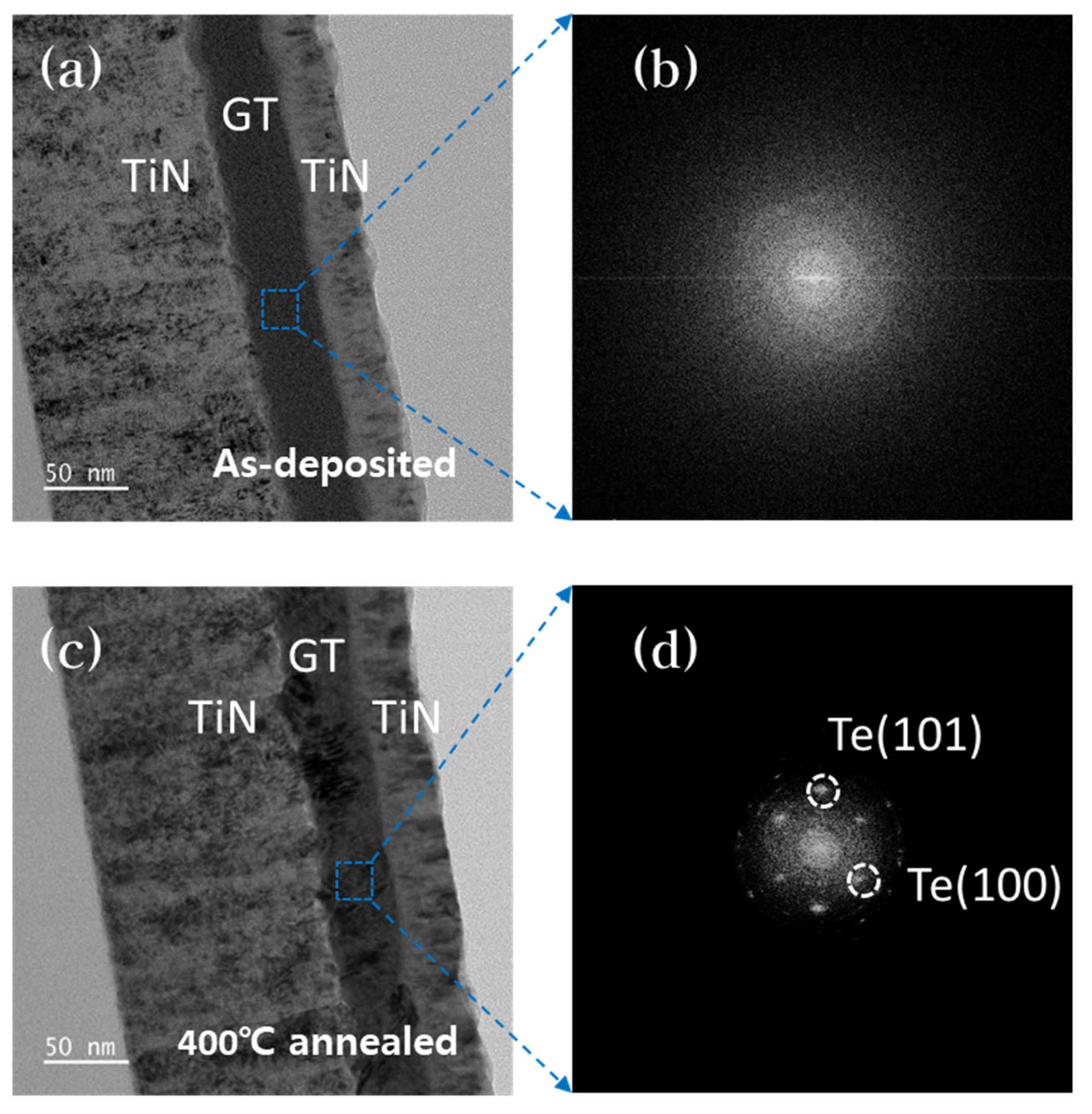Highly Reliable Ovonic Threshold Switch with TiN/GeTe/TiN Structure
Abstract
:1. Introduction
2. Materials and Methods
3. Results
4. Conclusions
Author Contributions
Funding
Institutional Review Board Statement
Informed Consent Statement
Data Availability Statement
Conflicts of Interest
References
- Wright, C.D.; Hosseini, P.; Diosdado, J.A.V. Beyond von-Neumann computing with nanoscale phase-change memory devices. Adv. Funct. Mater. 2013, 23, 2248. [Google Scholar] [CrossRef] [Green Version]
- Zhang, W.; Gao, B.; Tang, J.; Yao, P.; Yu, S.; Chang, M.F.; Yoo, H.; Qian, H.; Wu, H. Neuro-Inspired Computing Chips. Nat. Electron. 2020, 3, 371. [Google Scholar] [CrossRef]
- Sebastian, A.; Gallo, M.L.; Khaddam-Aljameh, R.; Eleftheriou, E. Memory devices and applications for in-memory computing. Nat. Nanotechnol. 2020, 15, 529. [Google Scholar] [CrossRef] [PubMed]
- Xu, M.; Mai, X.; Lin, J.; Zhang, W.; Li, Y.; He, Y.; Tong, H.; Hou, X.; Zhou, P.; Miao, X. Recent Advances on Neuromorphic Devices Based on Chalcogenide Phase-Change Materials. Adv. Funct. Mater. 2020, 30, 2003419. [Google Scholar] [CrossRef]
- Upadhyay, N.K.; Jiang, H.; Wang, Z.; Asapu, S.; Xia, Q.; Yang, J. Emerging Memory Devices for Neuromorphic Computing. Adv. Mater. Technol. 2019, 4, 1800589. [Google Scholar] [CrossRef] [Green Version]
- Upadhyay, N.K.; Joshi, S.; Yang, J.J. Synaptic electronics and neuromorphic computing. Sci. China Inf. Sci. 2016, 59, 061404. [Google Scholar] [CrossRef] [Green Version]
- Linn, E.; Rosezin, R.; Kügeler, C.; Waser, R. Complementary resistive switches for passive nanocrossbar memories. Nat. Mater. 2010, 9, 403. [Google Scholar] [CrossRef]
- Wang, Z.; Wu, H.; Burr, G.W.; Hwang, C.S.; Wang, K.L.; Xia, Q.; Ynag, J.J. Resistive switching materials for information processing. Nat. Rev. Mater. 2020, 5, 173. [Google Scholar] [CrossRef]
- Zhang, W.; Mazzarello, R.; Wutting, M.; Ma, E. Designing crystallization in phase-change materials for universal memory and neuro-inspired computing. Nat. Rev. Mater. 2019, 4, 150–168. [Google Scholar] [CrossRef]
- Lelmini, D.; Wong, H.S.P. In-memory computing with resistive switching devices. Nat. Electron. 2018, 1, 333–343. [Google Scholar] [CrossRef] [Green Version]
- Kuzum, D.; Yu, S.; Wong, H.S. Synaptic electronics: Materials, devices and applications. Nanotechnology 2013, 24, 382001. [Google Scholar] [CrossRef] [PubMed]
- Zhu, J.; Zhang, T.; Yang, Y.; Huang, R. A comprehensive review on emerging artificial neuromorphic devices. Appl. Phys. Rev. 2020, 7, 011312. [Google Scholar] [CrossRef]
- Borghetti, J.; Snider, G.S.; Kuekes, P.J.; Yang, J.J.; Stewart, D.R.; Williams, R.S. ‘Memristive’ switches enable ‘stateful’ logic operations via material implication. Nature 2010, 464, 873. [Google Scholar] [CrossRef] [PubMed]
- Yang, J.J.; Strukov, D.B.; Stewart, D.R. Memristive devices for computing. Nat. Nanotechnol. 2013, 8, 13. [Google Scholar] [CrossRef]
- Ohno, T.; Hasegawa, T.; Tsuruoka, T.; Terabe, K.; Gimzewski, J.; Aono, M. Short-term plasticity and long-term potentiation mimicked in single inorganic synapses. Nat. Mater. 2011, 10, 591–595. [Google Scholar] [CrossRef]
- Wang, S.; Song, L.; Chen, W.; Wang, G.; Hao, E.; Li, C.; Hu, Y.; Pan, Y.; Nathan, A.; Hu, G.; et al. Memristor-Based Intelligent Human-Like Neural Computing. Adv. Electron. Mater. 2022, 9, 2200877. [Google Scholar] [CrossRef]
- Jayaram, C.; Tekir, U. Von Neumann regular modules. Comm. Algebra 2018, 46, 2205–2217. [Google Scholar] [CrossRef]
- Zhou, J.; Kim, K.H.; Lu, W.W. Crossbar RRAM arrays: Selector device requirements during read operation. IEEE Trans. Electron Devices 2014, 61, 1369. [Google Scholar] [CrossRef]
- Park, W.Y.; Kim, G.H.; Seok, J.Y.; Kim, K.M.; Song, S.J.; Lee, M.H.; Hwang, C.S. Bipolar resistive switching with self-rectifying effects in Al/ZnO/Si structure. Nanotechnology 2010, 21, 195201. [Google Scholar] [CrossRef]
- Shi, L.; Zheng, G.; Tian, B.; Dkhil, B.; Duan, C. Research progress on solutions to the sneak path issue in memristor crossbar arrays. Nanoscale Adv. 2020, 2, 1811. [Google Scholar] [CrossRef]
- Hu, M.; Graves, C.E.; Li, C.; Li, Y.; Ge, N.; Montgomery, E.; Davila, N.; Jiang, H.; Williams, R.S.; Yang, J.J.; et al. Memristor-Based Analog Computation and Neural Network Classification with a Dot Product Engine. Adv. Mater. 2018, 30, 1705914. [Google Scholar] [CrossRef] [PubMed]
- Xia, Q.; Yang, J.J. Memristor crossbar arrays for brain-inspired computing. Nat. Mater. 2019, 18, 309–323. [Google Scholar] [CrossRef] [PubMed]
- Li, H.; Wang, S.; Zhang, X.; Wang, W.; Yang, R.; Sun, Z.; Feng, W.; Lin, P.; Wang, Z.; Sun, L.; et al. Memristive Crossbar Arrays for Storage and Computing Applications. Adv. Intell. Syst. 2021, 3, 2100017. [Google Scholar] [CrossRef]
- Kim, K.-H.; Gaba, S.; Wheeler, D.; Cruz-Albrecht, J.M.; Hussain, T.; Srinivasa, N.; Lu, W. A functional hybrid memristor crossbar-array/CMOS system for data storage and neuromorphic applications. Nano Lett. 2012, 12, 389. [Google Scholar] [CrossRef] [PubMed]
- Xia, Q.; Robinett, W.; Cumbie, M.W.; Banerjee, N.; Crdinali, T.J.; Yang, J.J.; Wu, W.; Li, X.; Tong, W.M.; Strukov, D.B.; et al. Memristor−CMOS Hybrid Integrated Circuits for Reconfigurable Logic. Nano Lett. 2009, 9, 3640. [Google Scholar] [CrossRef] [PubMed]
- Redaelli, A.; Pirovano, A.; Benvenuti, A.; Lacaita, A. Threshold switching and phase transition numerical models for phase change memory simulations. J. Appl. Phys. 2008, 103, 111101. [Google Scholar] [CrossRef]
- Adler, D.; Shur, M.S.; Silver, M.; Ovshinsky, S.R. Threshold switching in chalcogenide-glass thin films. J. Appl. Phys. 1980, 51, 3289. [Google Scholar] [CrossRef]
- Velea, A.; Opsomer, K.; Devulder, W.; Dumortier, J.; Fan, J.; Detavernier, C.; Jurczak, M.; Govoreanu, B. Te-based chalcogenide materials for selector applications. Sci. Rep. 2017, 7, 8103. [Google Scholar] [CrossRef] [Green Version]
- Laguna, C.; Bernard, M.; Bernier, N.; Rouchon, D.; Rochat, N.; Garrione, J.; Jannaud, A.; Nolot, E.; Meli, V.; Castellani, N.; et al. Multilayer OTS Selectors Engineering for High Temperature Stability, Scalability and High Endurance. In Proceedings of the 2021 IEEE International Memory Workshop (IMW), Dresden, Germany, 16–19 May 2021. [Google Scholar]
- Laguna, C.; Castellani, N.; Bernard, M.; Rochat, N.; Rouchon, D.; Sabbione, C.; Garrione, J.; Nolot, E.; Bourgeois, G.; Cyrille, M.C.; et al. Innovative Multilayer OTS Selectors for Performance Tuning and Improved Reliability. In Proceedings of the 2020 IEEE International Memory Workshop (IMW), Dresden, Germany, 17–20 May 2020; pp. 1–4. [Google Scholar]
- Zhu, M.; Ren, K.; Song, Z. Ovonic threshold switching selectors for three-dimensional stackable phase-change memory. MRS Bull. 2019, 44, 715. [Google Scholar] [CrossRef]
- Seo, H.K.; Ryu, J.J.; Lee, S.Y.; Park, M.; Park, S.G.; Song, W.; Kim, G.H.; Yang, M.K. Material and structural engineering of ovonic threshold switch for highly reliably performance. Adv. Electron. Mater. 2022, 8, 2200161. [Google Scholar] [CrossRef]
- Chen, Z.; Tong, H.; Li, X.; Wang, L.; Zhao, R.; Gu, W.; Miao, X. Experimental evidence for non-purely electric field-induced threshold switching and modified thermal-assisted model in GeTe phase change material. Appl. Phys. Lett. 2021, 118, 203502. [Google Scholar] [CrossRef]
- Vinod, E.; Singh, A.; Ganesan, R.; Sangunni, K. Effect of selenium addition on the GeTe phase change memory alloys. J. Alloys Compd. 2022, 537, 127. [Google Scholar] [CrossRef]
- Bruns, G.; Merkelbach, P.; Schlockermann, C.; Salinga, M.; Wuttig, M.; Happ, T.D.; Philipp, J.B.; Kund, M. Nanosecond switching in GeTe phase change memory cells. Appl. Phys. Lett. 2009, 95, 043108. [Google Scholar] [CrossRef]
- Chien, W.C.; Yeh, C.W.; Bruce, R.L.; Cheng, H.Y.; Kuo, I.T.; Yang, C.H.; Ray, A.; Miyazoe, H.; Kim, W.; Carta, F.; et al. A study on OTS-PCM pillar cell for 3-D stackable memory. IEEE Trans. Electron Devices 2018, 65, 5172–5179. [Google Scholar] [CrossRef]
- Lam, C.H. Phase change memory and its intended applications. In Proceedings of the 2014 IEEE International Electron Devices Meeting, San Francisco, CA, USA, 15–17 December 2014; p. 29. [Google Scholar]
- Anbarasu, M.; Wimmer, M.; Bruns, G.; Salinga, M.; Wuttig, M. Nanosecond threshold switching of GeTe6 cells and their potential as selector devices. Appl. Phys. Lett. 2012, 100, 143505. [Google Scholar] [CrossRef]
- Hu, W.; Zou, L.; Cao, C.; Guo, Y.; Bao, D. High speed and multi-level resistive switching capability of Ta2O5 thin films for nonvolatile memory application. J. Alloys Compd. 2016, 676, 356. [Google Scholar] [CrossRef]
- Zhang, W.; Kong, J.; Cao, Z.; Li, A.; Wang, L.; Zhu, L.; Li, X.; Cao, Y.; Wu, D. Bipolar Resistive Switching Characteristics of HfO2/TiO2/HfO2 Trilayer-Structure RRAM Devices on Pt and TiN-Coated Substrates Fabricated by Atomic Layer Deposition. Nanoscale Res. Lett. 2017, 12, 393. [Google Scholar] [CrossRef] [Green Version]
- Simanjuntak, F.; Chandrasekaran, S.; Lin, C.-C.; Tseng, T.-Y. Switching failure mechanism in zinc peroxide-based programmable metallization cell. Nanoscale Res. Lett. 2018, 13, 327. [Google Scholar] [CrossRef]






| Element | Weight % | Weight % Sigma | Atomic % |
|---|---|---|---|
| C | 31.91 | 0.29 | 52.74 |
| N | 13.34 | 0.33 | 18.90 |
| Si | 26.03 | 0.22 | 18.40 |
| Ti | 19.93 | 0.17 | 8.26 |
| Ge | 2.83 | 0.05 | 0.77 |
| Te | 5.96 | 0.63 | 0.93 |
| Total | 100.00 | 100.00 |
Disclaimer/Publisher’s Note: The statements, opinions and data contained in all publications are solely those of the individual author(s) and contributor(s) and not of MDPI and/or the editor(s). MDPI and/or the editor(s) disclaim responsibility for any injury to people or property resulting from any ideas, methods, instructions or products referred to in the content. |
© 2023 by the authors. Licensee MDPI, Basel, Switzerland. This article is an open access article distributed under the terms and conditions of the Creative Commons Attribution (CC BY) license (https://creativecommons.org/licenses/by/4.0/).
Share and Cite
Seong, D.; Lee, S.Y.; Seo, H.K.; Kim, J.-W.; Park, M.; Yang, M.K. Highly Reliable Ovonic Threshold Switch with TiN/GeTe/TiN Structure. Materials 2023, 16, 2066. https://doi.org/10.3390/ma16052066
Seong D, Lee SY, Seo HK, Kim J-W, Park M, Yang MK. Highly Reliable Ovonic Threshold Switch with TiN/GeTe/TiN Structure. Materials. 2023; 16(5):2066. https://doi.org/10.3390/ma16052066
Chicago/Turabian StyleSeong, Dongjun, Su Yeon Lee, Hyun Kyu Seo, Jong-Woo Kim, Minsoo Park, and Min Kyu Yang. 2023. "Highly Reliable Ovonic Threshold Switch with TiN/GeTe/TiN Structure" Materials 16, no. 5: 2066. https://doi.org/10.3390/ma16052066





